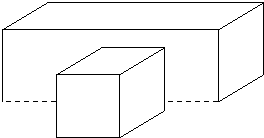for varying values of m and c. See Fig. 30.
One powerful global method for detecting edges is called the Hough transform.
Let us suppose that we are looking for straight lines in an image.
If we take a point
(x',y') in the image, all lines which pass through that
pixel have the form ![]()
for
varying values of m and c. See Fig. 30.
Fig. 30 Lines through a point
However, this equation can also be written as ![]()
where we now consider x' and y' to be
constants, and m and c as varying.
This is a straight line on a graph of c against m as shown in Fig. 31.
Each different line through the point (x',y') corresponds to one of the points on the line in (m,c) space.
Fig. 31 The C Compilation Model
Now consider two pixels p and q in (x,y) space which lie on the same line.
Fig. 32 Points on the same line
Taking this one step further,
To detect straight lines in an image, we do:
One useful property of the Hough transform is that the pixels which lie on the line need not all be contiguous.
For example, all of the pixels lying on the two dotted lines in Fig. 33 will be recognised as lying on the same straight line. This can be very useful when trying to detect lines with short breaks in them due to noise, or when objects are partially occluded as shown.

Fig. 33 Non-contiguous pixels on the same line
On the other hand, it can also give misleading results when objects happen to be aligned by chance, as shown by the two dotted lines in Fig. 34.

Fig. 34 Aligned objects
Indeed, this clearly shows that one disadvantage of the Hough transform method is that it gives an infinite line as expressed by the pair of m and c values, rather than a finite line segment with two well-defined endpoints.
One practical detail is that the y=mx+c form for representing a straight line breaks down for vertical lines, when m becomes infinite.
To avoid this problem, it is better to use the alternative
formulation given earlier,
![]()
as a means of describing straight lines.
Note,
however, that a point in (x,y) space is now represented by a
curve in ![]() space rather than a straight line.
space rather than a straight line.
Otherwise, the method is unchanged.
The Hough transform can be used to detect other shapes in an image as well as straight lines.
For example, if we wish to find circles,
with equation
![]()
Now:
In practice, the technique takes rapidly increasing amounts of time for more complicated curves as the number of variables (and hence the number of dimensions of A) increases
So the method is really only of use for simple curves.